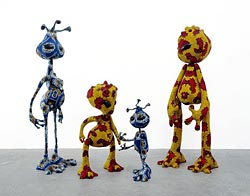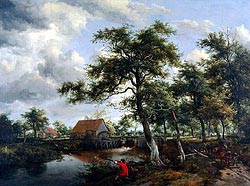 |
 |
 |
 |
 |
Balance can be achieved with just color values alone. A small amount of color can offset the visual weight of a large area of
neutral values. Similarly, a small area of warm color can balance a large area of cool color. |
|
 |
 |
 |
 |
 |
|
 |
 |
 |
 |
 |
This Pop Art image illustrates symmetrical color balance. The color distribution on the right side mirrors that of the left
side. |
 |
Allan D'Arcangelo
Proposition #9
1966
Acrylic on canvas
Walker Art Center
Art Center Acquisition Fund

|
|
 |
 |
 |
 |
 |
|
 |
 |
 |
 |
 |
This sculpture is an example of balancing color asymmetrically. The smaller red cherry has more visual weight than the
neutral grey of the spoon, even though the spoon is larger than the cherry. |
 |
Claes Oldenburg, Coosje van Bruggen
Spoonbridge and Cherry
1985-1988
Aluminum, stainless steel, paint
Walker Art Center
Gift of Frederick R. Weisman in honor of his parents, William and Mary Weisman

|
|
 |
 |
 |
 |
 |
|
 |
 |
 |
 |
 |
Even though the sizes and shapes of these figures vary, the large orange figure and small blue figure on the right
balance the large blue figure and small orange figure on the left. |
 |
Yinka Shonibare
Dysfunctional Family
1999
Wax-printed cotton, polyester, wood, plastic
Walker Art Center
Butler Family Fund

|
|
 |
 |
 |
 |
 |
|
 |
 |
 |
 |
 |
Balance through color is one principle that unifies this composition. Although the canvas is filled with grayed tones
of blue and green, orange (the complement of blue) is a secondary theme and can be seen on the roofs, the cattle and in the grass.
Our attention is further drawn to the figure in the red jacket, showing that a small area of warm color can offset a larger area of
cool color. |
 |
Meindert Hobbema
Wooded Landscape with Watermill
1665
Oil on canvas
The Minneapolis Institute of Art
The William Hood Dunwoody Fund

|
|
 |
 |
 |
 |
 |









